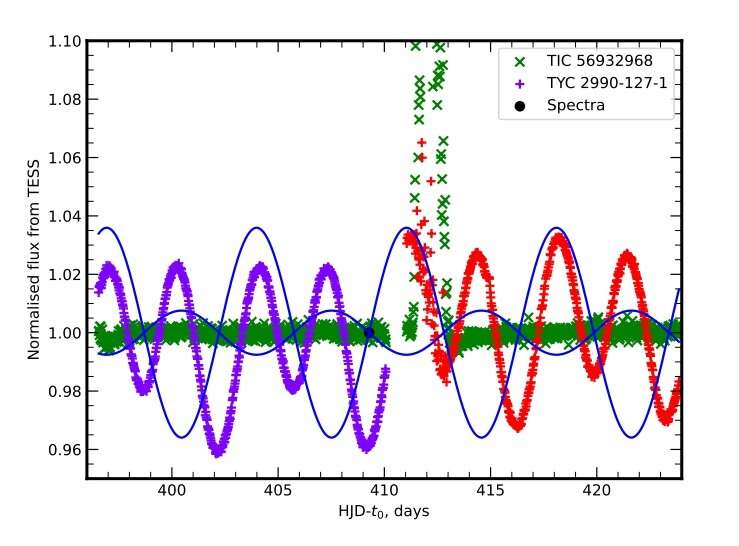Normalized TESS light curves for TYC 2990-127-1 and nearby star together with schematic plot of the orbital solution (the solid lines). The black circle shows the moment when one LAMOST spectrum was observed. Data points from TESS orbits with numbers 49 and 50 are shown as magenta and red pluses respectively. Credit: Kovalev et al, 2022
Using the Large Sky Area Multi-Object Fibre Spectroscopic Telescope (LAMOST), astronomers have investigated a binary star known as TYC 2990-127-1. Results of the study suggest that this object is an Algol-type double-lined spectroscopic binary system. The finding is reported in a paper published April 22 on arXiv.org.
So far, the majority of binaries have been detected by Doppler shifts in their spectral lines; hence, these systems are called spectroscopic binaries. Observations show that in some spectroscopic binaries, spectral lines from both stars are visible, and these lines are alternately double and single. These systems are known as double-lined spectroscopic binaries (SB2).
TYC 2990-127-1 was initially reported as a double or multiple star in which two components are separated from each other by about 0.9 arcseconds. Subsequent observations of this source have found that one of the stars has a radial velocity of -44.7 km/s and parallax of approximately 1.43 mas. One study, based on an analysis of cross-correlation functions, suggested that TYC 2990-127-1 may be an SB2.
Now, a team of astronomers led by Mikhail Kovalev of the Chinese Academy of Sciences (CAS) present further evidence confirming the SB2 nature of TYC 2990-127-1.
"In this paper, we use LAMOST medium-resolution spectra to confirm that TYC 2990-127-1 is an SB2 system of sub-giant and red giant stars, orbiting each other on a circular orbit with period ∼ 1 week," the researchers explained.
The results show that the primary subgiant is much heavier than the secondary red giant as their masses were estimated to be 0.76 and 0.16, respectively (or even two times more massive—according to other model). This indicates that there was mass transfer in this system and the astronomers suppose that the red giant expanded and reached its Roche lobe and lost a significant fraction of its mass to the subgiant. It was noted that such a high mass ratio is typical for Algol-type systems.
Furthermore, the researchers conducted a simulation that supports the Algol-type scenario for TYC 2990-127-1. It was found that the secondary star is transferring mass to the primary at a rate of about 2.5 x 10-9 solar masses per year. This is consistent with previous works suggesting that Algol-type systems may be undergoing rapid mass loss.
In general, Algol-type binaries are a class of eclipsing binary stars related to the prototype member of this class, known as Beta Persei or Algol. They are semi-detached systems whose less-massive component transfers mass to the more massive component due to filling its Roche lobe, causing mass and angular momentum loss.
As noted in the paper, TYC 2990-127-1 has an orbital period of approximately 7.05 days. The effective temperatures of the primary and secondary stars were measured to be 5,592 and 4,769 K. The astronomers predict that the system will enter into the common envelope phase in the subsequent evolution with the expansion of the secondary star.
More information: Mikhail Kovalev et al, TYC 2990-127-1: an Algol-type SB2 binary system of subgiant and red giant with a probable ongoing mass-transfer. arXiv:2204.10680v1 [astro-ph.SR], arxiv.org/abs/2204.10680
© 2022 Science X Network























